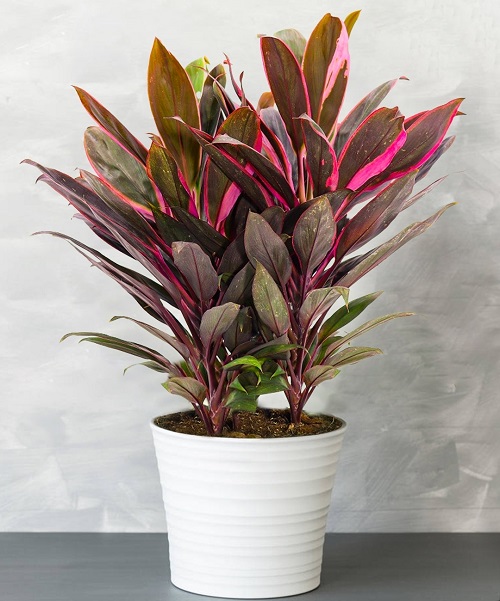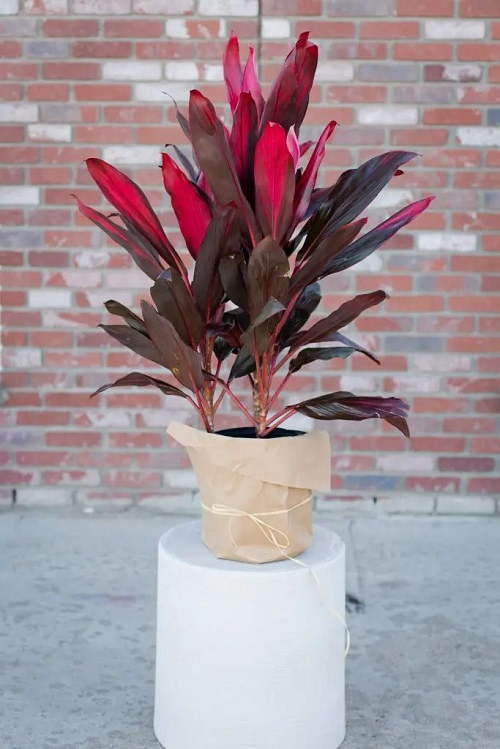Learn about Growing Red Sister Plant Indoors and add a splash of vibrant color to your living space with its striking foliage!

Hey folks! Get ready to be captivated by the bold foliage of the Red Sister Plant—prized for its ornamental and air-purifying benefits! With its stunning burgundy and green leaves, this tropical plant is not only a striking addition to any indoor garden but also offers air-purifying benefits. If you’re ready to give your home a vibrant makeover, let’s dive into everything you need to know about Growing Red Sister Plant Indoors!
- Botanical Name: Cordyline fruticosa
- Popular as—Good Luck Plant, Ti Plant, Hawaiian Ti Plant, Florida Ti Plant
- Attains a height of 4-6 feet indoors
- Prefers a temperature range of 65-95 F or 18-35 C
- Needs direct sunlight to flaunt the best colors
- Toxic to pets, if ingested
Red Sister Plant Profile
Popular as Red Sister Plant, Cordyline fruticosa is a tropical evergreen plant indigenous to the Pacific Islands. It has gained popularity among gardeners worldwide as an ornamental choice, thanks to its capacity to infuse any landscape with a tinge of exotic elegance.
The elongated and glossy leaves come in an array of colors ranging from deep burgundy to bright pink and green. Standing at a handsome height of about 4-6 feet, its elegant, bushy growth pattern, colorful leaves, air-purifying properties, and low-care demands make it an ideal indoor plant. However, if you are a pet parent, keep your fur babies away from this alluring houseplant, as their gut will not appreciate the colorful bits of the Red Sister Plant!
Ideal Pot Size
The shrubby growth of the Red Sister Plant demands a bigger pot size. Go for an 8-10 inches pot while starting out. Ensure the pot is one size bigger than the plant’s root ball, as excessive space will pool water at the bottom, while a cramped space will stunt root growth.
You may repot it to a one-size bigger container if you want the plant to reach its matured height. Otherwise, you may need to cut out the roots that will peep out from the drainage holes after a certain period. This method, coupled with trimming of the leaves and stem, will ensure the plant stays at a standard maintainable size indoors.
Propagating Red Sister Plant

Propagating Red Sister Plant via stem cuttings is pretty straightforward. All you need is a healthy, disease-free plant and a few simple steps to multiply this beauty:
- Select a stem that is firm and has a diameter of at least ¼ inch.
- Using a pair of clean and sharp gardening shears, make a clean cut just below a node. The cutting should be around 4-6 inches long and have at least 2-3 nodes.
- Remove any leaves from the lower half of the stem, leaving only a few at the top.
- Dip the cut end of the stem into rooting hormone powder, shaking off any excess.
- Prepare a pot with a well-draining potting mix and make a hole in the soil with a pencil or your finger.
- Insert the cutting into the soil, making sure that the node where you made the cut is buried in the soil. Gently press the soil around the cutting to hold it in place.
- Water the soil well and place the pot in a warm and bright location, but not in direct sunlight.
Check on the cutting regularly and mist it with water if it starts to look dry. After a few weeks, you should start to see new growth emerging from the top of the cutting.
Requirements for Growing Red Sister Plant

Light
Cordyline fruticosa grows best under direct sunlight, which becomes challenging while growing indoors. So it is best to keep the plant in the South or West facing the windows of your house. If you have a sunny balcony that receives 5-6 hours of bright morning sunlight, nothing like that. In case, your home receives very little sunlight, consider supplementing the plant with grow lights, or high-voltage LED strips to enjoy the vibrant coloration of the foliage.
The plant survives low light as well, but the foliage will take a dull green hue, with the plant showing stunted growth in such a condition. However, keep the plant away from the intense afternoon sun, as that might burn the foliage tips.
Soil
The Red Sister Plant prefers well-draining soil that is rich in organic matter. It does best in soils with a pH range of 6.0 to 6.5. Use a potting mix that is specifically formulated for tropical plants, or create your own mix by combining equal parts of peat moss, perlite, and sand. Avoid heavy, waterlogged soils that can cause root rot.
Water
Cordyline fruticosa requires regular watering to keep its soil moist but not waterlogged. Keep an eye on the top inch of the medium and allow it to dry out between the watering sessions. Overwatering can lead to root rot, while underwatering can cause its leaves to wilt and drop.
To follow the right balance, follow a deep watering session every week, i.e., water the plants until it seeps out of the drainage holes. This method will ensure the roots get enough water while avoiding any fungal issues.
Temperature & Humidity
The Red Sister Plant thrives in warm temperatures ranging from 65°F to 95°F (18°C to 35°C). It can tolerate slightly cooler temperatures but not below 55°F (13°C). Temperatures below the minimum point will rip the plant off its vibrant colors and attractive stature. Protect it from cold drafts and sudden temperature changes, which can cause its leaves to yellow and drop.
Cordyline fruticosa prefers high humidity levels ranging from 50% to 70% that help prevent the tips of its leaves from turning brown and dry. If the air in your home is dry, consider using a humidifier or placing a tray of water near the plant. You can also mist its leaves with tepid water to increase humidity levels.
Red Sister Plants Care

Fertilizer
The plant is not a heavy feeder, but the gorgeous foliage benefits from an application of a balanced, water-soluble 15-15-15 blend once a month during the spring and summer months. Ensure to dilute the feed to one-fourth its strength to avoid salt burn in the roots. Also, do not fertilize when the plant is dormant in the colder months.
Pests & Diseases
Red Sister Plants are mostly pest and disease-resistant; however, they can be vulnerable to mealybugs, scale insects, and spider mites. These can be eradicated with insecticidal soap or any fungicide like neem oil, and any remaining eggs or other pests can subsequently be removed by wiping the leaves with water and soap solution. Keep your Red Sister Plant safe from pests by keeping an eye on petioles and the abaxial surface of leaves, where pests mostly tend to attack.






